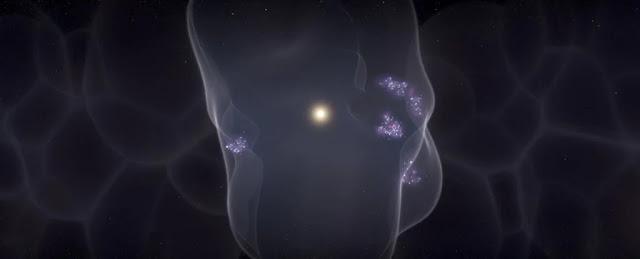The Solar System floats in the middle of a peculiarly empty region of space.

This region of low-density, high-temperature plasma, about 1,000 light-years across, is surrounded by a shell of cooler, denser neutral gas and dust. It's called the Local Bubble, and precisely how and why it came to exist, with the Solar System floating in the middle, has been a challenge to explain.
A team of astronomers led by the Harvard & Smithsonian Center for Astrophysics (CfA) has now mapped the Local Bubble with the highest precision yet – and found that the Local Bubble was likely carved out of the interstellar medium by a series of supernova explosions millions of years ago.
This is consistent with previous studies, with an additional sting in the tail: the still-expanding Local Bubble is responsible for regions of heightened star formation at its perimeter.
"This is really an origin story; for the first time we can explain how all nearby star formation began," says astronomer Catherine Zucker of the Space Telescope Science Institute, who conducted the research while at the CfA.
The Local Bubble was only discovered relatively recently, in the 1970s and 1980s, through a combination of optical, radio, and X-ray astronomy. Gradually, these surveys and observations revealed a huge region about 10 times less dense than the average interstellar medium in the Milky Way galaxy.
Since we know supernovae can carve out cavities in space, sweeping up gas and dust as they expand outwards, this seemed a reasonable explanation for the Local Bubble.
But piecing together how and when was more tricky. It's hard, for one thing, to measure the dimensions of a region of space when you're inside it; and doubly hard to measure a void when you're surrounded by bright stars and other cosmic objects.
Zucker and her team used data from the most recent Gaia data release – an ongoing project to map the positions and motions of stars in the Milky Way with the highest precision yet – to map the gas and young stars within 200 parsecs (around 650 light-years) of the Sun.
They found that all young stars and star-forming regions are on the "surface" of the Local Bubble.
This makes sense; as a supernova expands outwards, it shocks and compresses the material it expands into. This creates dense knots in molecular gas floating in the interstellar medium that collapse under their own gravity to form baby stars.
Next, the researchers conducted simulations and tracebacks of the motions of star-forming regions to model the Bubble's expansion. This allowed them to reconstruct its history, matching the outcomes of their calculations against their map of the bubble.
They found that the Bubble's history started about 14.4 million years ago, first with a period of stellar birth, followed by the supernovae of massive, short-lived stars.
"We've calculated that about 15 supernovae have gone off over millions of years to form the Local Bubble that we see today," Zucker explains.
It's currently about 165 parsecs (538 light-years) in radius, and it's still expanding outwards, although relatively slowly, at a rate of about 6.7 kilometers (4 miles) per second.
So why is the Solar System in the middle? Well, that's purely coincidence.
"When the first supernovae that created the Local Bubble went off, our Sun was far away from the action," says physicist and astronomer João Alves of the University of Vienna in Austria.
"But about five million years ago, the Sun's path through the galaxy took it right into the bubble, and now the Sun sits – just by luck – almost right in the Bubble's center."
According to the researchers, this suggests that the Milky Way is likely full of similar bubbles, since the likelihood of this happening is very low if the bubbles are rare. The idea evokes a Milky Way structured similarly to a sea sponge, or perhaps a flattened wheel of Swiss cheese.
The next step along this line of enquiry is to try and find and map the other bubbles. Their locations, sizes, shapes, and how they interact with each other could be clues that help us better understand the star formation and evolutionary history of the Milky Way.
The next Gaia data release, due to drop later this year, should prove extremely useful for this.
"This is an incredible detective story, driven by both data and theory," says astronomer Alyssa Goodman of Harvard University.
"We can piece together the history of star formation around us using a wide variety of independent clues: supernova models, stellar motions, and exquisite new 3D maps of the material surrounding the Local Bubble."
The research has been published in Nature.





No comments:
Post a Comment